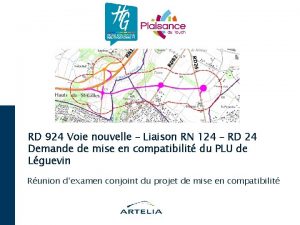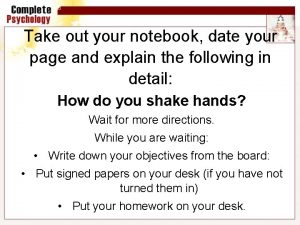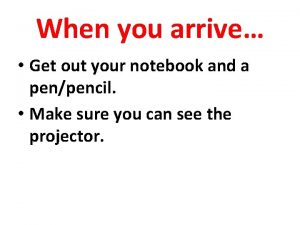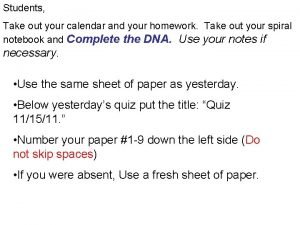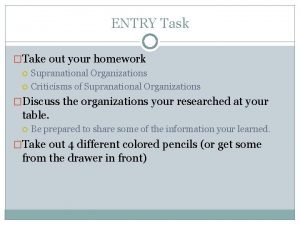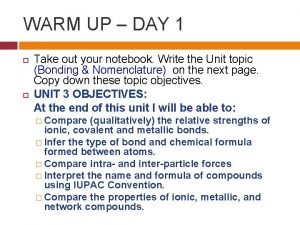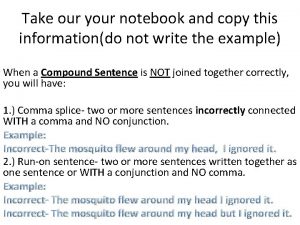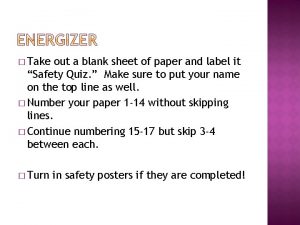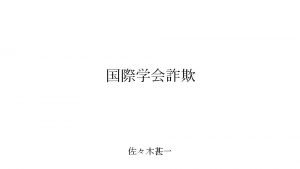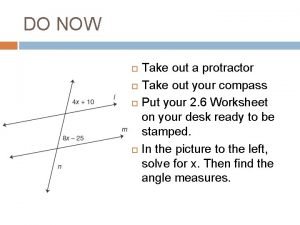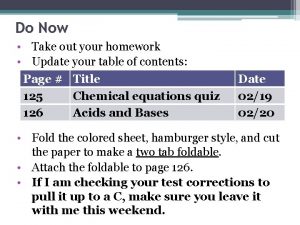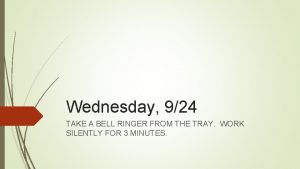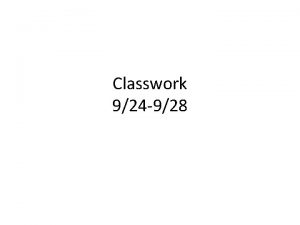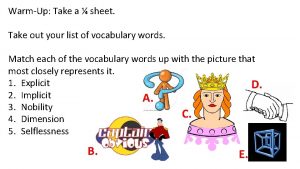Do Now 924 o 1 Take out your






























- Slides: 30

Do Now 9/24 o 1 Take out your questions for “The Bone Collector” and finish the last two. Forensic Science: Fundamentals & Investigations, Chapter 2

o 2 https: //www. youtube. com/watch? v=Jgzdh. UA Jr. BA Forensic Science: Fundamentals & Investigations, Chapter 2

Do Now 9/25 o o 3 Take out your list of steps for investigating a crime scene and try to add one or two steps. HW: Test Tuesday Forensic Science: Fundamentals & Investigations, Chapter 2

Chapter 2 Crime Scene Investigation and Evidence Collection By the end of this chapter you will be able to: o o o 4 Summarize Locard’s exchange principle Identify four examples of trace evidence Distinguish between direct and circumstantial evidence Identify the type of professionals who are present at a crime scene Describe how evidence from a crime scene is analyzed All Rights Reserved South-Western / Cengage Learning © 2012, 2009 Forensic Science: Fundamentals & Investigations, Chapter 2

Chapter 2 Crime Scene Investigation and Evidence Collection By the end of this chapter you will be able to: o o 5 Summarize three steps of a crime scene investigation Explain the importance of securing the crime scene Identify the methods by which a crime scene is documented Demonstrate proper technique in collecting and packaging trace evidence Forensic Science: Fundamentals & Investigations, Chapter 2

Principle of Exchange Established by Dr. Edmond Locard, the principle states: o When a person comes in contact with an object or another person, a cross-transfer of physical material can occur o Study of the material can determine the nature and duration of the transfer 6 Forensic Science: Fundamentals & Investigations, Chapter 2

“Wherever he steps, whatever he touches, whatever he leaves, even unconsciously, will serve as a silent witness against him. Not only his fingerprints or his footprints, but his hair, the fibers from his clothes, the glass he breaks, the tool mark he leaves, the paint he scratches, the blood or semen he deposits or collects. All of these and more, bear mute witness against him. This is evidence that does not forget. It is not confused by the excitement of the moment. It is not absent because human witnesses are. It is factual evidence. Physical evidence cannot be wrong, it cannot perjure itself, it cannot be wholly absent. Only human failure to find it, study and understand it, can diminish its value. ” -Paul Kirk on the Locard Exchange Principle o 7 Forensic Science: Fundamentals & Investigations, Chapter 2

Types of Evidence Direct evidence Testimony by a witness about what that witness saw, heard, or did 8 Forensic Science: Fundamentals & Investigations, Chapter 2

Types of Evidence Circumstantial evidence • also called Indirect • trace evidence Physical evidence • e. g. , fingerprints Biological evidence • 9 Forensic Science: Fundamentals & Investigations, Chapter 2 e. g. , blood or hairs

Types of Evidence Explain why this would be or would not be trace evidence 10 Forensic Science: Fundamentals & Investigations, Chapter 2

Utah Forensics o 11 https: //forensicservices. utah. gov/testingservices/trace-evidence/ Forensic Science: Fundamentals & Investigations, Chapter 2

The Crime Scene Investigation Team Who is at the crime scene? o o o 12 Police and District attorney (possibly) Crime scene investigators Medical examiners Detectives Specialists Forensic Science: Fundamentals & Investigations, Chapter 2

The Seven S’s of Crime Scene Investigation 1. 2. 3. 4. 5. 6. 7. 13 Secure the scene Separate the witnesses Scan the scene Seeing the scene Sketch the scene Search for evidence Secure the collected evidence Forensic Science: Fundamentals & Investigations, Chapter 2

Crime-Scene Sketch Form 14 Forensic Science: Fundamentals & Investigations, Chapter 2

Crime-Scene Search Patterns 15 Forensic Science: Fundamentals & Investigations, Chapter 2

Packaging the evidence Crease a clean paper and place evidence in the X position 2. Fold in the left and right sides, and then fold in the top and bottom 3. Put the bindle into a plastic or paper evidence bag affixing a seal over the opening 4. Write your name on the seal 1. 16 Forensic Science: Fundamentals & Investigations, Chapter 2

Evidence ID Forms 17 Forensic Science: Fundamentals & Investigations, Chapter 2

Chain of Custody Maintaining a chain of custody log is essential to present credible evidence in court 18 Forensic Science: Fundamentals & Investigations, Chapter 2

Chain of Custody (cont’d. ) 1. Bag the evidence Add identification Seal it Sign it across the sealed edge 2. Sign over to a lab technician Open bag on non-sealed edge 3. Return items to the evidence bag Seal evidence bag in another bag Sign the evidence log 19 Forensic Science: Fundamentals & Investigations, Chapter 2

Analyze the Evidence o o 20 Facts result from collected evidence processed by the forensic lab Lead detective aims to see how facts fit into the crime scenario Forensic Science: Fundamentals & Investigations, Chapter 2

Analyze the Evidence Lab results can: o Show reliability of witness accounts o Establish the identity of suspects or victims o Show suspects to be innocent or link them with a scene or victim 21 Forensic Science: Fundamentals & Investigations, Chapter 2

Do Now 9/26 o o 22 What does Locard’s exchange principle describe? TEST TUESDAY Forensic Science: Fundamentals & Investigations, Chapter 2

Crime Scene Reconstruction Crime scene reconstruction involves: o Forming a hypothesis of the sequence of events o From before the crime was committed through its commission 23 Forensic Science: Fundamentals & Investigations, Chapter 2

Staged Crime Scenes When lab results don’t match up with the testimony of witnesses Common examples: o o o 24 Staging a fire—to cover bankruptcy Staging a suicide—to cover a murder Staging a burglary—to collect insurance money Forensic Science: Fundamentals & Investigations, Chapter 2

Staged Crime Scenes Was the crime scene staged? Consider: o o 25 Does the type of wound match the weapon? Could the wound be easily self-inflicted? What were the mood and actions of the victim before the event? What were the mood and actions of the suspect before the event? Forensic Science: Fundamentals & Investigations, Chapter 2

. . . Summary. . o o o 26 Locard’s exchange principle: • Contact between people and objects can transfer material that can determine the nature and duration of the transfer Evidence can be direct or indirect • Physical or biological traces A crime scene investigation team consists of police, detectives, crime scene investigators, medical investigators, and specialists. Forensic Science: Fundamentals & Investigations, Chapter 2

. . . . Summary o o o 27 Investigations consist of recognizing, documenting, and collecting evidence. First responding officers identify the extent of the crime scene, secure it, and segregate witnesses. Crime scene investigators document the crime scene. Evidence is collected, packaged, and labeled. The evidence is analyzed and interpreted to fit the crime scenario. Forensic Science: Fundamentals & Investigations, Chapter 2

o 28 https: //www. youtube. com/watch? v=i. SLAWd. U Gw. ME Forensic Science: Fundamentals & Investigations, Chapter 2

o 29 https: //www. youtube. com/watch? v=p. NEmn. V d. GHok Forensic Science: Fundamentals & Investigations, Chapter 2

Do Now 9/27 o o 30 What is one way that professional responders could have handled the Jon. Benet Ramsey case differently to better preserve potential evidence? Upcoming Assessment: TEST TUESDAY Forensic Science: Fundamentals & Investigations, Chapter 2
 Rd924
Rd924 Get out one direction
Get out one direction Take out your notebook
Take out your notebook Take out your homework
Take out your homework Take out your notebooks
Take out your notebooks Checked homework
Checked homework Take out your homework
Take out your homework Take out your homework
Take out your homework Take out your homework
Take out your homework Take out your notebook
Take out your notebook Take out your homework
Take out your homework Fulcrum load
Fulcrum load Take a point o on your notebook
Take a point o on your notebook Take out your homework
Take out your homework Take out your homework
Take out your homework Take out your homework
Take out your homework Take out your notebook
Take out your notebook Copy this in your notebook
Copy this in your notebook Take out your homework
Take out your homework Now i see it now you don't
Now i see it now you don't Take a bus or take a train
Take a bus or take a train You put your right foot in you put your right foot out
You put your right foot in you put your right foot out Dialogue grade 11
Dialogue grade 11 Oh that rugged cross my salvation
Oh that rugged cross my salvation Medea take out
Medea take out Signing naturally unit 9.10 minidialogue 3 answers
Signing naturally unit 9.10 minidialogue 3 answers Take out a sheet of paper
Take out a sheet of paper Take out a sheet of paper
Take out a sheet of paper Translate the following sentences into spanish
Translate the following sentences into spanish Take out a piece of paper
Take out a piece of paper Fictional character names
Fictional character names
